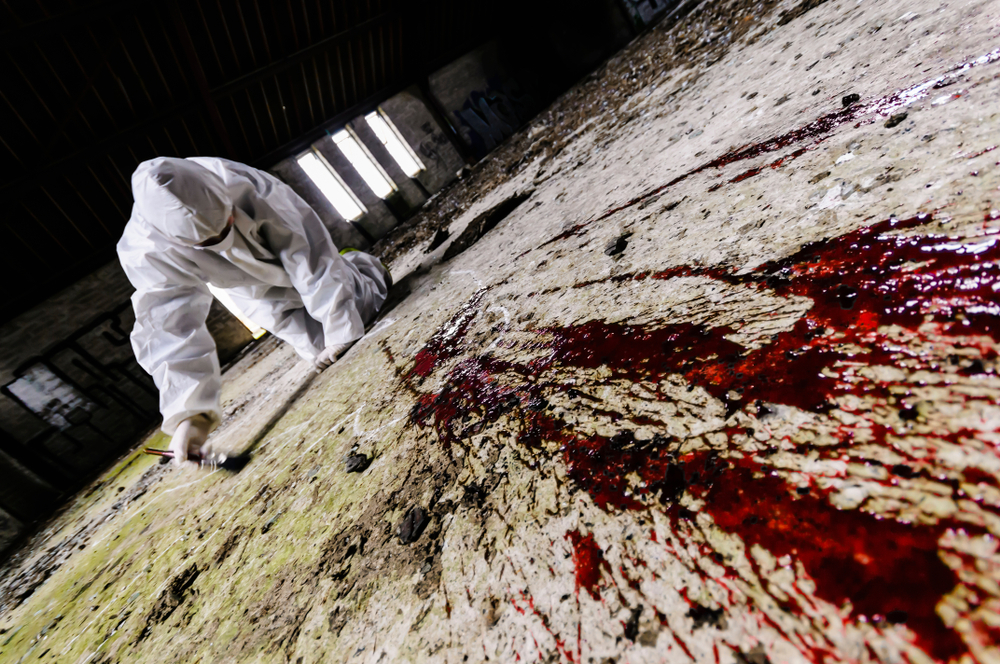
In honor of the spookiest month of the year, it’s time to dive into the science behind blood pattern analysis and its evolving role in forensics.
TV’s Dexter may have glorified it, but did you know that the analysis of bloodstains at crime scenes is actually a widely used forensic investigational method?
And while the field is still rather immature, there’s some pretty slick science behind it, too.
Bloodstain pattern analysis (BPA) is a scientific discipline that uses the study of bloodstains left at crime scenes to help determine what happened. It is often used in cases where there are no witnesses to a crime, or when traditional forensic evidence such as fingerprints or DNA are not available.

BPA is based on the principle that every time a drop of blood falls to the ground, it will create a stain with certain characteristics that can be used to reconstruct the event that caused it. By studying the shape, size, and distribution of bloodstains, forensic scientists can often determine how the victim was injured, what type of weapon was used, and even the approximate height of the person who inflicted the injuries. The traces include drips, smears, and spatters, which are created when drops of blood radiate from the impact of a bullet or blunt instrument until they encounter a surface and stain it.
BPA is a highly specialized field, and there are only a handful of certified bloodstain pattern analysts in the United States. However, the science is constantly evolving, and new techniques are being developed all the time that can help investigators solve even the most complex cases.
The History of Blood Pattern Analysis
Actionable analysis of evidence gathered based on blood’s physical behavior at crime scenes has roots in late 19th-century Europe. The first methodical study of blood spatters, titled "Concerning the Origin, Shape, Direction and Distribution of the Bloodstains Following Head Wounds Caused by Blows," was published in 1895 by Dr. Eduard Piotrowski of the University of Krakow in Poland. This would set the stage for other early research by leading investigators in the early 20th-century Germany and France, including Dr. Paul Jeserich and Dr. Victor Balthazard.
The field was somewhat touch-and-go until 1955, when its landmark moment would occur. It was then when Dr. Paul Kirk submitted an affidavit of his findings in the highly publicized case of the State of Ohio v. Samuel Sheppard. Kirk showed the position of the assailant and the victim, and his research revealed that the attacker struck the victim with his left hand. Significantly, Sheppard was right-handed.
BPA has played an important role in other murder trials since – OJ?Simpson (1994–1995, verdict of not guilty) Phil Spector (2007–2009, retrial verdict of guilty), perhaps most notably.
More on the Science of BPA

Forensics professionals working in local, state, and federal investigation units use BPA to work backwards from blood traces at crime scenes, allowing them to reconstruct the locations and actions of the people and weapons involved.
Since blood behaves according to certain scientific principles, these investigators can examine the blood evidence left behind and draw logical conclusions as to what may have occurred. It might appear to be totally random and non-evidential to the untrained eye, but using science, analysts can categorize stains at crime scenes by gathering information from spatter patterns, transfers, voids, and other notable marks that occur during bloodshed. This form of physical evidence requires the analyst to recognize and interpret patterns to determine how those patterns were created.
Biology (blood behavior), physics (cohesion, capillary action, velocity) and mathematics (geometric distances and angles) are the primary branches of science used to assist investigators in answering key investigatory questions. These might include:
- Where did the blood come from?
- What caused the wounds?
- From what direction was the victim wounded?
- How were the victim(s) and perpetrator(s) positioned?
- What movements were made after the bloodshed?
- How many potential perpetrators were present?
- Does the bloodstain evidence support or refute witness statements?
The actual properties of the blood – such as its pH or the number of red blood cells – is where the biology comes into play. These factors can vary greatly from person to person and must be analyzed first before moving on to the actual mechanics and dynamics involved with the blood.
Physics is perhaps the most important factor in BPA. Reconstructing a crime scene forensically is a complicated problem, but it can be solved utilizing fluid mechanics that involve tracing the behavior of blood under various forces and ambient conditions. Since blood is a complex fluid containing both liquid (the plasma) and solid (the blood cells) components, the challenge becomes more difficult – but strides are being made within the field to overcome it.
Conclusion
While BPA analysis does aid in crime scene reconstruction, its role in legal proceedings remains blurry. The loose licensing requirements for BPA analysis certification are one reason for this – the field is still young and searching for standardization that will allow it to be taken more seriously on the grand legal scale. But progress is being made and the future of the field remains bright.
References